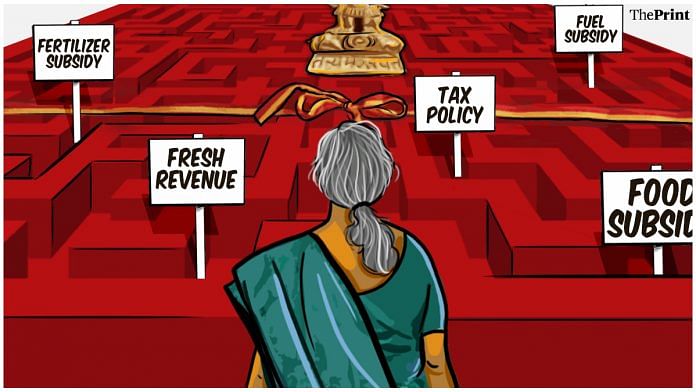Nirmala Sitharaman is in her fourth year as finance minister. The change in her approach to budgeting, from the somewhat adventurous beginning in 2019 till now, is notable for a growing realism.
The start was a trial by fire, with the numbers going badly wrong. Tax revenue fell short by a sharp 18.4 per cent, partly because the economic slowdown had set in even before Covid came, and partly because midway through the year she announced an unprecedented cut in corporate tax rates — prompted, quite obviously, by the prime minister’s visit a few days later to the US, with his itinerary including meetings with corporate chieftains.
The result at year-end was a reported fiscal deficit of 4.6 per cent, up significantly from the originally budgeted 3.4 per cent.
The next year was no better, when the full impact of Covid served to shrink GDP. Corporation tax revenue shrank by 17.8 per cent, while collections from goods and services tax (GST) dropped by 8.3 per cent.
Interestingly, the finance minister saw opportunity in the bleak situation. She decided that piling on more bad news wouldn’t make much of a difference, and cleaned up her books, thereby ending the wholesale fudging of fiscal-deficit numbers that had been going on. Bringing off-balance sheet borrowing into the government’s books doubled the deficit to a record 9.2 per cent, but confidence in the government’s accounting practices improved.
In her third Budget, Ms Sitharaman signalled that she had realised the folly of budgeting over-reach. In contrast to previous years, she projected only modest revenue numbers for 2021-22.
The result: Actual collections overshot the original projections by 13.4 per cent. That provided the fiscal cushion for neutralising the impact of non-tax revenue shortfalls and allowed the government to continue with Covid-related handouts like free foodgrain for the poor. The year ended with a deficit that was more or less the same as originally projected.
Also read: Is India’s defence business a good news story or bad? Perhaps both, but changing for the better
This year is headed for a repeat of that performance. Tax revenue is running well ahead of projections, despite petroleum taxes having been reduced. But on the expenditure side the subsidy outlay has ballooned once again, partly because of the fallout of the Ukraine war in the form of a sharp increase in fertiliser prices, which has not been passed on to farmers, and partly because the government decided to continue with the supply of free foodgrain.
If one is to go by the minister’s statement in Parliament this week, she will deliver on the budgeted deficit level of 6.4 per cent of GDP. In both the latest years, it is her modest revenue projections that have helped save the blushes in a turbulent period involving unplanned expenditures.
Judging by newspaper reports, the Budget for next year will continue projecting only modest tax revenue growth.
In terms of tax policy, the corporation tax rates now match international benchmarks, while peak income tax rates have been jacked up for outsize incomes. Both are where they should be. But the multiplicity of capital gains tax rates remains, as it does for GST, while tariff levels have been going up. It looks unlikely that these issues will be addressed in the coming Budget and the forthcoming meeting of the GST Council, so the job will remain half done and the perennial chopping and changing of rates will continue.
Meanwhile, the fiscal deficit remains far too high, being close to the pre-Covid peak of 6.5 per cent in the financial crisis year of 2009-10. How this can be brought down, while providing bigger Budgets for defence, education and health care, is the challenge.
The fact is that India’s Budgets are too small for the demands being made on its governments. So, there is really no escape from cutting the subsidies and handouts (like free foodgrain) which have ballooned during the Covid years. That should lower the deficit to below 6 per cent of GDP — still too high, given the elevated level of public debt.
The additional outlays needed would therefore need to be financed by fresh revenue, possibly by raising the average GST level simultaneously with a convergence of rates.
By special arrangement with Business Standard
Also read: A road paved with surprises — why Indian economy’s steady course can’t be taken for granted



